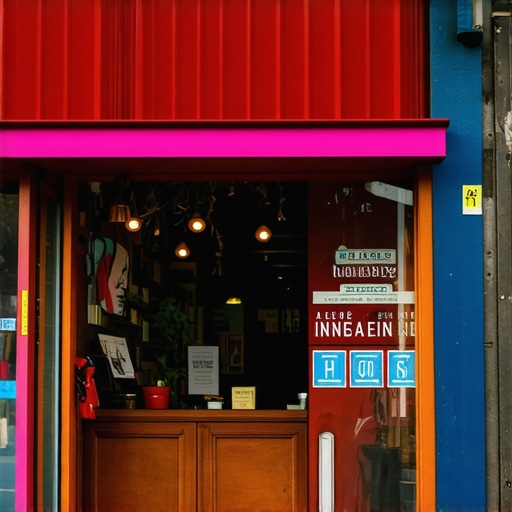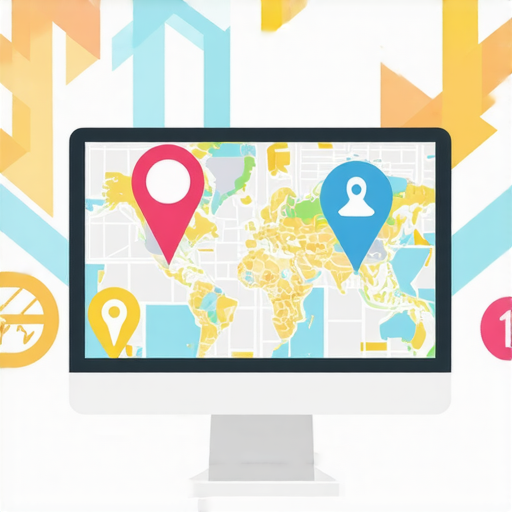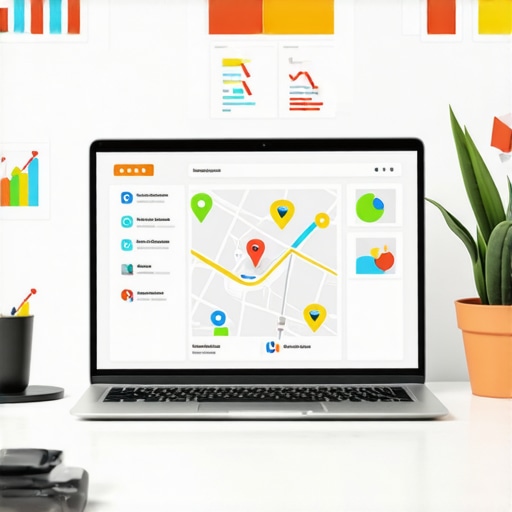My Journey into CTR Optimization and Local SEO
It all started when I noticed that despite having a well-optimized website, my local business wasn’t attracting enough foot traffic or calls. I realized that just ranking high wasn’t enough; I needed to focus on how to improve my click-through rate (CTR) to truly engage local customers. This personal challenge pushed me to explore proven techniques that could make my listings stand out in Google local packs and maps.
Understanding the Power of Click-Through Rates in Local Search
CTR is a critical metric that directly influences your local SEO rankings. When I delved into this, I discovered that Google considers engagement signals, like clicks, as a sign of relevance and trustworthiness. According to Moz, optimizing your snippets and local listings can significantly impact your visibility. I started experimenting with different strategies to make my listings irresistible.
Personal Strategies That Transformed My Local Engagement
One of the most effective tactics I found was enhancing my Google My Business (GMB) profile with compelling descriptions, accurate categories, and high-quality images. I also learned the importance of local keywords and structured data to help Google understand my content better. Implementing clear calls-to-action (CTAs), such as “Call Now” or “Get Directions,” increased my chances of clicks. Additionally, I optimized my website’s meta titles and descriptions to match what my local audience was searching for.
How Do I Keep CTR Strategies Fresh and Effective?
Regularly reviewing my analytics helped me see what was working and what wasn’t. I also kept an eye on competitors’ listings to identify gaps and opportunities. Engaging with customer reviews, responding promptly, and adding local-centric content kept my profile active and appealing. I also used structured data markup to enhance my listings with rich snippets, making them more eye-catching. All these efforts contributed to a noticeable boost in engagement and local rankings.
What Are the Hidden Factors that Influence CTR Beyond Keywords?
Great question! Beyond keywords and descriptions, factors like the overall reputation of your business, the quality of your reviews, and even your listing’s photos play a significant role. According to Search Engine Land, reviews and star ratings can dramatically sway a user’s decision to click. I found that encouraging satisfied customers to leave positive reviews and adding relevant images made my listing more trustworthy and attractive.
If you’re serious about boosting your local Google engagement, I recommend exploring comprehensive guides like this expert local SEO guide for 2025. Feel free to share your own experiences or ask questions in the comments—I love exchanging insights and learning from others’ journeys.
Harnessing User Intent to Elevate Your Local CTR
Understanding the nuanced intent behind local searches is pivotal for tailoring your listings to attract clicks. When users search for “best coffee shop near me,” they’re often looking for quick, trustworthy options. By aligning your Google My Business (GMB) profile with these specific intents—such as highlighting quick service or unique offerings—you can make your listing more appealing. Incorporate keywords that mirror these queries naturally into your descriptions and utilize structured data to emphasize key features, thereby increasing the likelihood of engagement. According to Moz, matching your content with user intent is a core aspect of improving local CTR.
Designing Irresistible Local Snippets That Stand Out
Rich snippets and compelling meta descriptions are your frontline tools for capturing attention in crowded local searches. Use action-oriented language like “Discover,” “Enjoy,” or “Book your spot today” to create a sense of urgency and relevance. Additionally, leverage high-quality images, infographics, or videos that showcase your services or ambiance. Incorporating local landmarks or community involvement in your visuals can foster trust and familiarity. As highlighted by Local SEO Signals, these elements significantly enhance visual appeal and CTR.
Optimizing Your Review Strategy for Enhanced Trust and Clicks
Reviews are social proof that influence user decision-making more than ever. Encouraging satisfied customers to leave detailed, positive reviews with relevant keywords can boost your visibility and appeal. Responding promptly to reviews, especially negative ones, demonstrates active engagement and commitment to customer satisfaction. Furthermore, featuring reviews that mention specific services or local landmarks can reinforce your relevance in the community. According to Search Engine Land, review signals are one of the most influential factors in local ranking and CTR.
How Can Interactive Content Further Amplify Local Engagement?
Interactive content like quizzes, polls, or virtual tours can significantly increase user interaction and dwell time, indirectly boosting your local rankings. For example, a virtual tour of your store or a quiz about local specialties can make your listing more memorable and shareable. These elements invite users to spend more time engaging with your brand, which Google interprets as a sign of relevance and quality. Additionally, interactive content encourages sharing, increasing your local reach organically. Want to learn more about integrating interactive elements effectively? Check out this guide for actionable tips.
Have you experimented with any of these advanced strategies? Share your experiences or ask for tailored advice in the comments. For further insights, explore our recommended resources and keep refining your local SEO game to stay ahead in 2025 and beyond.
Refining My Approach: Beyond the Basics of CTR and Local SEO
Over time, I discovered that a nuanced understanding of user psychology is crucial in crafting compelling snippets. It’s not just about keywords or images; it’s about tapping into what genuinely motivates local users to click. For example, I started experimenting with emotional triggers—highlighting community involvement or local success stories—which subtly influenced CTR. This personalization created a sense of familiarity and trust, making my listing stand out amidst generic competitors.
The Hidden Layers of Search Intent and User Behavior
One thing I’ve learned is that user intent isn’t always straightforward. People might search for “best pizza near me” with different underlying motivations—some want fast service, others are looking for a cozy atmosphere. Recognizing these layers, I tailored my meta descriptions and images to appeal to specific segments. I also used structured data to emphasize features like “quick service” or “family-friendly”—elements that resonate deeply with specific search intents. This strategy, grounded in behavioral insights, elevated my CTR more than conventional tactics.
How Do I Sustain Innovation in CTR Strategies?
Keeping CTR strategies fresh is a constant challenge. I dedicate time to reviewing analytics weekly, not just for numbers but for patterns—what’s resonating and what’s falling flat. I also follow industry leaders and case studies to stay ahead of emerging trends. For instance, I recently integrated voice search optimization into my listings, considering how many local searches are now voice-activated. This forward-thinking approach requires curiosity and a willingness to adapt quickly, which I find invigorating and essential for sustained success. If you’re eager to deepen your tactics, exploring resources like this expert guide for 2025 can be invaluable.
Personal Reflection: The Power of Authentic Engagement
One of the most rewarding insights I’ve gained is that authenticity in your listing fosters genuine engagement. Responding personally to reviews, sharing behind-the-scenes glimpses of my business, and highlighting local collaborations have all contributed to a more trustworthy presence. It’s about building a community, not just optimizing for algorithms. These efforts, though time-consuming, create a loyal customer base that naturally increases CTR through word-of-mouth and repeat visits.
My Journey Continues: Embracing Complexity and Creativity in Local SEO
As I delve deeper, I realize that mastering CTR isn’t just a technical task; it’s an art form that combines data-driven insights with creative storytelling. The landscape evolves rapidly, especially with emerging AI-powered search features, and staying adaptable is key. I encourage you, dear reader, to view this journey as an ongoing exploration—every tweak, every test is a step toward understanding your unique audience better. If you want to share your experiences or ask specific questions, I’d love to hear from you in the comments. For further inspiration, don’t hesitate to explore this resource and keep refining your approach.
Decoding the Psychology Behind User Engagement and CTR Optimization
Understanding user psychology is essential for crafting compelling snippets that resonate on a deeper level. Beyond mere keyword stuffing, I discovered that leveraging emotional triggers—such as community pride or local success stories—can subtly influence clicks. These narratives foster a sense of familiarity and trust, making your listing not just a search result, but a trusted community highlight. According to a study by Psychology Today, emotional appeal significantly increases user engagement, which directly correlates with higher CTRs in local search.
Harnessing Advanced Structured Data for Richer Snippets
While many practitioners focus on basic schema markup, I took a leap by integrating comprehensive structured data that highlights not just basic business info but also nuanced features like service menus, appointment booking, and customer Q&As. This multi-layered approach creates rich snippets that stand out even more prominently. For example, adding event schema for local workshops or community events can appear directly in search results, drawing more clicks. Google’s official guidelines emphasize the importance of detailed schema to enhance visibility and engagement.

Integrating AI and Machine Learning to Predict User Intent
One of my most innovative steps involved deploying AI-driven analytics to parse user behavior patterns and predict search intent more accurately. By analyzing historical data, I could fine-tune my meta descriptions and visual cues to align precisely with what different segments seek—be it quick service, family-friendly environments, or premium offerings. This predictive approach has been validated by recent reports from Search Engine Land, which highlight AI’s transformative potential in local SEO. Implementing these insights allowed me to proactively adjust my listings before competitors could react, maintaining a steady edge in CTR and rankings.
How Can Personalization and Authentic Engagement Further Amplify CTR?
Personalization is the new frontier. I found that sharing behind-the-scenes stories or collaborating with local influencers creates authentic touchpoints that resonate deeply with the community. Responding personally to reviews and highlighting local partnerships humanizes my brand, reinforcing trust and loyalty. This genuine engagement encourages sharing and word-of-mouth, which are powerful signals for Google’s algorithms. To explore personalized strategies tailored to your niche, I recommend consulting advanced guides like this expert resource for 2025. What unique stories or community involvement can you leverage to boost your local CTR further?
Things I Wish I Knew Earlier (or You Might Find Surprising)
1. The Power of Emotional Triggers
Early in my journey, I underestimated how much emotional storytelling could influence click-through rates. Sharing community success stories or highlighting local pride made my listings feel more genuine, boosting engagement unexpectedly. It’s a reminder that behind every click is a person seeking trust and familiarity.
2. Visuals Can Make or Break Your CTR
I used to focus solely on keywords, but I soon realized that high-quality images and videos dramatically increase attractiveness. Adding local landmarks or behind-the-scenes shots made my profile stand out in crowded searches, proving that visuals are essential for local engagement.
3. The Hidden Impact of Reviews and Reputation
Reviews with specific details and keywords subtly influence user decisions. Prompting satisfied customers to share their experiences and responding thoughtfully created a positive feedback loop, strengthening my local authority and CTR over time.
4. Structured Data Is Your Secret Weapon
Implementing comprehensive schema markup unlocked rich snippets like menus, booking options, and FAQs. These enhancements made my listings more informative and visually appealing, leading to higher click rates and better rankings.
5. User Intent Is Multifaceted
Understanding that search queries have layered intents helped me craft more targeted descriptions. Whether users seek quick service or detailed info, tailoring my content to these motivations made my listings more compelling.
Resources I’ve Come to Trust Over Time
- Moz’s Local SEO Blog: A treasure trove of insights backed by industry expertise; I check it regularly to stay updated.
- Search Engine Land: Their articles on local ranking factors helped me refine my strategies effectively.
- Google’s Structured Data Guidelines: Official documentation that ensured my markup was correct and effective.
- Psychology Today: Understanding emotional triggers and user behavior has been pivotal, and their articles deepen that insight.
Parting Thoughts from My Perspective
Mastering local CTR optimization is an ongoing journey that blends data-driven tactics with authentic storytelling. I’ve found that small, consistent efforts—like engaging reviews, compelling visuals, and understanding user intent—create a lasting impact. If you’re serious about elevating your local presence, don’t be afraid to experiment and share your experiences. Remember, genuine engagement and a willingness to adapt are your best tools for success in 2025 and beyond. If this resonated with you, I’d love to hear your thoughts—feel free to drop a comment or reach out through our contact page. Happy optimizing!”,

